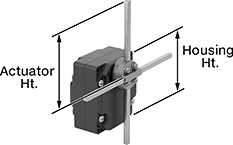Filter by
Actuator Style
Switch Action
Conduit Thread Type
Electrical Connection Type
Switch Starting Position
Housing Length
Number of Circuits Controlled
Number of Mounting Holes
Actuation Force
Housing Depth
Switch Type
Number of Terminals
Housing Height
Enclosure Rating
Conduit Connection Gender
Conduit Thread Size
CSA File Number
Specifications Met
UL File Number
Export Control Classification Number (ECCN)
REACH
RoHS
DFARS Specialty Metals
Choosing an Electrical Switch
More
Limit Switches

G
When a moving object contacts the actuator on these switches, they open or close a circuit. They have the rapid-closing action of a snap-acting switch, but with a larger actuator. This makes them a good choice for use with large objects—for instance, a box on a conveyor runs into the switch, stopping the conveyor.
Switches with a T-rod actuator have four rods extending in different directions from a pivot point. If an object contacts any of the rods from any direction, these switches actuate. Since they have such a large actuation area, they’re great for detecting moving parts when your machine tool isn’t perfectly aligned.
Housing | Conduit | |||||||||||||||
|---|---|---|---|---|---|---|---|---|---|---|---|---|---|---|---|---|
| Style | No. of Circuits Controlled | Switch Starting Position | Switch Action | Industry Designation | Switching Current @ Voltage | Max. Voltage | Operating Temp. Range, °F | Actuator Ht. | Lg. | Ht. | Dp. | Housing Material | Thread Size | Environmental Rating | Each | |
T-Rod Actuator Style | ||||||||||||||||
With Screw Terminals | ||||||||||||||||
| G | 2 | 2 Off (Normally Open) or 2 On (Normally Closed) | Stays Switched (Maintained) | DPDT | 10 A @ 240 V AC, 250 V DC | 240V AC 250V DC | -13° to 158° | 7.9" | 3.4" | 3.7" | 2.1" | Zinc | PG-13.5 | IP54 | 00000000 | 0000000 |

























